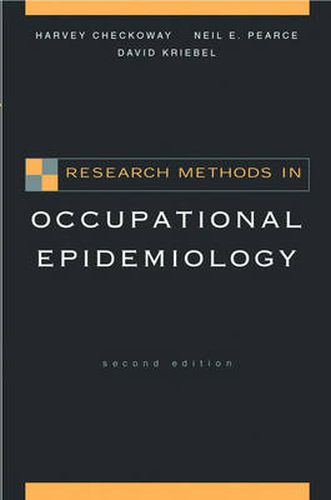Readings Newsletter
Become a Readings Member to make your shopping experience even easier.
Sign in or sign up for free!
You’re not far away from qualifying for FREE standard shipping within Australia
You’ve qualified for FREE standard shipping within Australia
The cart is loading…






From reviews of the first edition: ‘An up-to-date presentation of research methods in occupational epidemiology is provided by this well-written and well-structured textbook… This excellent book is likely to become a standard reference text. All those engaged in occupational epidemiology should obtain a copy.’ -International Journal of Epidemiology ‘A remarkably well-written, easy-to-read, concise synopsis of the whole range of methods used in occupational epidemiology. Many examples, tables, diagrams, with comprehensive summaries of statistical concepts and various methods used to model exposure and dose. A valuable reference for basic and intermediate work.’ -APHA Occupational Health and Safety Newsletter ‘This book is a worthwhile introductory text to the emerging field of occupational epidemiology. It gives an extensive discussion of the practical problems to be faced in planning and executing occupational studies, and will be of particular benefit to persons starting work in this field of study.’ -Chronic DiseasesThis widely used text provides a clear and critical summary of research approaches to the epidemiological study of workplace hazards. It describes the historical development of occupational epidemiology, methods for characterizing occupational exposures, and techniques for designing and implementing epidemiologic studies in this area. The relative strengths and limitations of various study designs for investigating specific health outcomes are emphasized. Also included are more advanced discussions of statistical analysis, exposure and dose modelling, and subsequent applications of data derived from epidemiologic research, as in meta-analysis, pooled analysis, and statistical analysis, exposure and dose modelling, and risk assessment. Since the first edition was published 15 years ago, there have been numerous advances in epidemiologic methods to accommodate a broadened scope of investigations of occupational exposures and associated adverse health outcomes. Thus, in this Second Edition the authors have updated their discussions of methodology to include such topics as case-cohort and case-crossover designs and statistical analysis of repeated measures data, and have expanded the examples they use throughout the book to demonstrate the applications of these methods to a wide range of acute and chronic health outcomes. They have also added a new chapter on occupational health surveillance. Their text is unique for its strong emphasis on the definition and assessment of exposures, the application of quantitative exposure data to epidemiologic models, and the recognition that improvements in workplace risk identification and quantification will come from careful integration of these approaches.
$9.00 standard shipping within Australia
FREE standard shipping within Australia for orders over $100.00
Express & International shipping calculated at checkout
From reviews of the first edition: ‘An up-to-date presentation of research methods in occupational epidemiology is provided by this well-written and well-structured textbook… This excellent book is likely to become a standard reference text. All those engaged in occupational epidemiology should obtain a copy.’ -International Journal of Epidemiology ‘A remarkably well-written, easy-to-read, concise synopsis of the whole range of methods used in occupational epidemiology. Many examples, tables, diagrams, with comprehensive summaries of statistical concepts and various methods used to model exposure and dose. A valuable reference for basic and intermediate work.’ -APHA Occupational Health and Safety Newsletter ‘This book is a worthwhile introductory text to the emerging field of occupational epidemiology. It gives an extensive discussion of the practical problems to be faced in planning and executing occupational studies, and will be of particular benefit to persons starting work in this field of study.’ -Chronic DiseasesThis widely used text provides a clear and critical summary of research approaches to the epidemiological study of workplace hazards. It describes the historical development of occupational epidemiology, methods for characterizing occupational exposures, and techniques for designing and implementing epidemiologic studies in this area. The relative strengths and limitations of various study designs for investigating specific health outcomes are emphasized. Also included are more advanced discussions of statistical analysis, exposure and dose modelling, and subsequent applications of data derived from epidemiologic research, as in meta-analysis, pooled analysis, and statistical analysis, exposure and dose modelling, and risk assessment. Since the first edition was published 15 years ago, there have been numerous advances in epidemiologic methods to accommodate a broadened scope of investigations of occupational exposures and associated adverse health outcomes. Thus, in this Second Edition the authors have updated their discussions of methodology to include such topics as case-cohort and case-crossover designs and statistical analysis of repeated measures data, and have expanded the examples they use throughout the book to demonstrate the applications of these methods to a wide range of acute and chronic health outcomes. They have also added a new chapter on occupational health surveillance. Their text is unique for its strong emphasis on the definition and assessment of exposures, the application of quantitative exposure data to epidemiologic models, and the recognition that improvements in workplace risk identification and quantification will come from careful integration of these approaches.